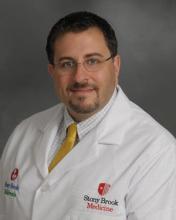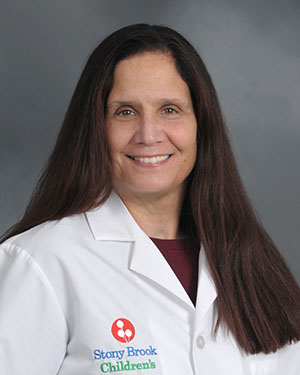Navigation Neurosurgery
Pediatric Neurosurgery
Stony Brook Children's is a major clinical and research center for pediatric neurosurgery and the only pediatric neurosurgery program in Suffolk County that has two board-certified neurosurgeons. (There are only 278 in all of North America.)
We offer comprehensive, multidisciplinary services, collaborating closely with our colleagues in pediatric neurology, pediatric intensive care and other subspecialties. In particular, we are committed to using advanced surgical techniques and minimally invasive procedures to minimize trauma and complications, and help children get back to their lives sooner.
Our patients also have access to all the ancillary services available in an academic medical center, including state-of-the-art diagnostic imaging, Child Life services and more. Each year, we perform about 200 neurosurgical operations and see about 1,200 children on an outpatient basis.
Services
Stony Brook's Pediatric Neurosurgery team diagnoses and treats a broad range of brain and spine problems. The conditions most often referred to us are hydrocephalus (commonly referred to as water on the brain) and all types of brain and spinal cord tumors.
As part of Suffolk County’s only academic medical center, we have access to the most advanced technology and treatments available. One type of treatment that we frequently use is neuroendoscopy, which allows us to go into the ventricles (interconnected, fluid-filled spaces) of the brain and place catheters (thin tubes) to open cysts using a minimally invasive approach.
We also treat craniosynostosis (a birth defect caused when the joints between the bones of a baby’s skull close prematurely) using minimally invasive endoscopic techniques. For the treatment of tumors, we use a sophisticated three-dimensional, computer-generated stereotaxic technique that enables us to locate and treat hard-to-reach tumors that would otherwise be untreatable.
In addition, we serve as one of the area's major pediatric neurosurgical centers for trauma.
The scope of diagnoses that we treat includes:
- Arnold Chiari Deformity
- Arteriovenous Malformation
- Brain Aneurysm
- Craniosynostosis
- Epilepsy
- Hydrocephalus
- Moyamoya
- Pediatric Brain Tumors
- Pediatric Spine Surgery
- Skull Base Tumors
- Spinal Tumors
- Tethered Spinal Cord
To learn more about the Stony Brook Pediatric Neurosciences Center, visit the center's page here.
Our Team
Dr. Chesler and Dr. Egnor are the only board-certified pediatric neurosurgeons in Suffolk County. There are only 278 in all of North America. Both Dr. Chesler and Dr. Egnor use advanced surgical techniques and minimally invasive endoscopic techniques to minimize blood loss and trauma and complications and help children get back to their lives sooner.
Patients have access to the full complement of other pediatric specialists and subspecialists at Stony Brook Children’s Hospital. These include neuroradiologists and neuro-interventional radiologists, pediatricians, pediatric intensivists, pediatric oncologists, radiation oncologists, pediatric nurses, child-life specialists and social workers. This collaborative approach brings children expert, coordinated care that addresses their highly individual needs.
Locations
Advanced Speciality Care Commack
500 Commack Road, Suite 201Commack, NY
For appointments: (631) 444-1213
East Setauket New York Spine & Brain Surgery
24 Research Way, Suite 200East Setauket, NY
For appointments: (631) 444-1213
Riverhead New York Spine and Brain Surgery
54 Commerce Drive, Suite 7Riverhead, NY 11901
Patient Resources
Hydrocephalus Foundation, Inc.
Offers comprehensive information about hydrocephalus.
Spinal Cord Tumor Association, Inc.
A not-for-profit organization formed by spinal cord tumor survivors for the purpose of supporting survivors and their families.
Research and Education
Our team has concentrated significant research efforts, both basic science and clinical studies, focused on understanding and treating hydrocephalus.
The working theory is that hydrocephalus is related to the pulsatility (rhythmic beating) of the flow of cerebrospinal fluid to the brain. The goal is to develop better shunts or other devices to treat hydrocephalus.
Dr. Egnor and colleagues have published numerous scientific papers describing their efforts and discoveries. Dr. Chesler's area of research interest is the development of new treatments for brain tumors and also includes the development of new therapies for the treatment of brain cancers.
Advances and Recognitions
Division Chief Dr. Michael Egnor has been recognized repeatedly for his teaching ability as well as his work with abused and neglected children. His awards include twice receiving the "Outstanding Teaching Abilities in Pediatrics from the Department of Pediatrics." He also has received the Child Abuse and Neglect Volunteer and Professional of the Year Award in Health Brookhaven Youth Bureau.
Dr. David A. Chesler, an expert in craniosynostosis, was recently part of the surgical team at Stony Brook Children's Hospital to perform the first known surgery of its kind in the world on triplets, whose skulls fused prematurely. Today, the triplets, Jackson, Hunter and Kaden Howard, continue to thrive and meet every developmental milestone.
Definitions
Also known as chiari malformations (CMs), these structural defects are in the cerebellum, the part of the brain that controls balance. CMs may develop when the bony space is smaller than normal, causing the cerebellum and brain stem to be pushed down toward the upper spinal canal. The resulting pressure on the cerebellum and brain stem may block the flow of cerebrospinal fluid—the clear liquid that surrounds and cushions the brain and spinal cord—to and from the brain and affect functioning.
A condition that affects the head/skull and face and occurs in one out of 2,500 births. The bones of the skull close prematurely, limiting or distorting the skull's growth. It is characterized in infancy by an abnormal but characteristic head shape.
Minimally invasive surgery using catheters (thin tubes).
A disorder in which too much cerebrospinal fluid, usually under high pressure, accumulates in the cavities of the brain. This can be caused by a birth defect, brain tumor, infection, hemorrhage or brain injury. Hydrocephalus is also commonly referred to as water on the brain.
Symptoms and signs occur due to pressure on neural structures, with resultant irritation or destruction.
This condition is characterized by damage to the intervertebral discs, the gel-like cushions that separate each segment of the backbone or spine. Pain and stiffness in the neck and/or back can result, as well as pain that spreads to the back of the head, trunk, shoulders, arms, hands, legs and feet.
A break in the cartilage surrounding a disc in the spine, causing pressure on spinal nerves that produce pain down the arms or legs. Usually preceded by an episode of neck or lower back pain, or a long history of intermittent neck or back pain.
Commonly referred to as a "broken" neck or back, spinal cord injuries can lead to paralysis and loss of motor function. Correction of defects associated with spinal cord injury can improve neurologic function.
This occurs when the spinal cord attaches itself to the bony spine and causes abnormal stretching of the spinal cord. It can result in permanent damage to the muscles and nerves in the lower body and legs.



